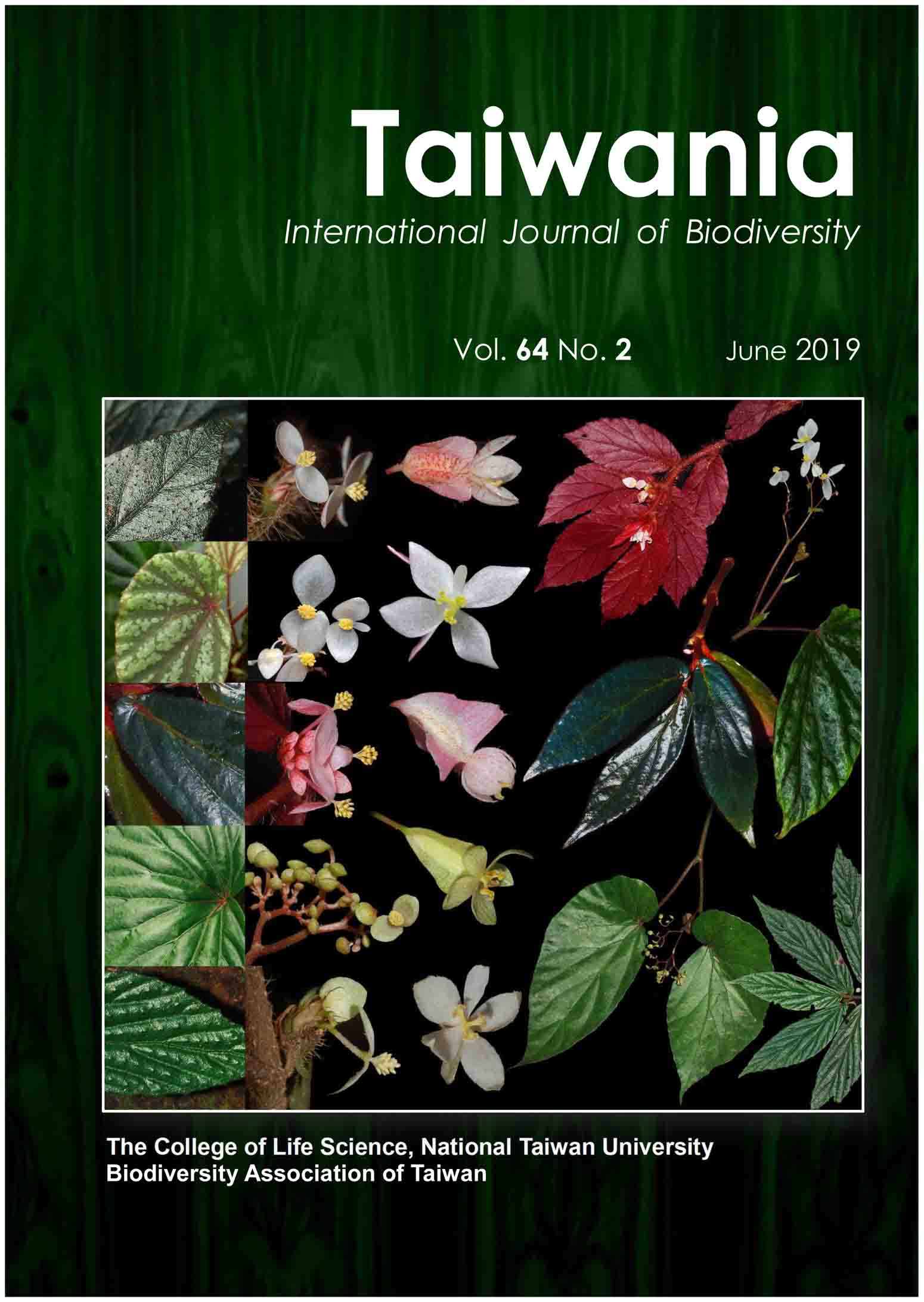Note
Deviation from the Brownian motion expectation implies episodic adaptive divergences in traits of Lithocarpus species in Taiwan
Min-Xin Luo, Meng-Yuan Huang, Chih-Kai Yang, Yi-Zhou He, Bing-Hong Huang, Pei-Chun Liao
Published on: 13 May 2019
Page: 202 - 208
DOI: 10.6165/tai.2019.64.202
Abstract
Adaptive trait divergence is usually episodic rather than universal in a phylogeny. To determine whether trait divergence reaches an extreme level (i.e. deviation from neutrality), the evolutionary rate of the species and intraspecific variation must be taken into account. Accordingly, we attempt to explore the trend of trait divergence over divergence times conditioned on the genetic distance. The Brownian motion (BM) model, a commonly used random-walk process for describing the neutral evolution of traits, is used to simulate the distribution of trait divergence under neutrality. The observed trait divergences are then compared to the BM expectations to detect outliers, which are considered to be selected. We assessed the ability of this method to characterize trait divergence under selection among 14 Lithocarpus species in Taiwan. The results are consistent with the previous inference of phylogenetic constraint based on tests of the phylogenetic signal, but further signals of adaptive and conserved trait divergences are detected between some lineages derived from particular nodes (common ancestors), indicating differential investments in growth rate and chemical defense among some endemic species in Taiwan. These results show that the adaptive divergence of environment-related traits is transient, episodic, and punctuated. Under strong selection pressure, the trait divergence after standard deviation correction will be more significant because the trait variance within the population decreases. However, it tends to be an overestimation of conservative evolution in older common ancestors due to the larger standard deviation produced from diverse descendants. Nevertheless, this study still provides a simple approach to detect adaptive divergence in a phylogenetic framework.
Keyword: Adaptive divergence, Brownian motion model, Continuous trait, Lithocarpus, Phylogenetic constraint, Trait evolution
Literature Cited
Beilharz, R.G., B.G. Luxford and J.L. Wilkinson 1993. Quantitative genetics and evolution: Is our understanding of genetics sufficient to explain evolution? J. Anim. Breed. Genet. 110(1-6): 161-170.
DOI: 10.1111/j.1439-0388.1993.tb00728.xView Article
Google Scholar
Blomberg, S.P., T. Garland, A.R. Ives and B. Crespi 2003. Testing for phylogenetic signal in comparative data: Behavioral traits are more labile. Evolution 57(4): 717-745.
DOI: 10.1554/0014-3820(2003)057[0717:TFPSIC]2.0.CO;2View Article
Google Scholar
Cannon, C.H. and P.S. Manos 2003. Phylogeography of the Southeast Asian stone oaks (Lithocarpus). J. Biogeogr. 30(2): 211-226.
DOI: 10.1046/j.1365-2699.2003.00829.xView Article
Google Scholar
Carter, J.F., V. Barwick and (Eds) 2011. Good practice guide for isotope ratio mass spectrometry, FIRMS, The Forensic Isotope Ratio Mass Spectrometry (FIRMS) Network.
Chiang, T.-Y., K.-H. Hung, T.-W. Hsu and W.-L. Wu 2004. Lineage sorting and phylogeography in Lithocarpus formosanus and L. dodonaeifolius (Fagaceae) from Taiwan. Ann. Missouri Bot. Gard. 91: 207-222.
Crisp, M.D. and L.G. Cook 2012. Phylogenetic niche conservatism: what are the underlying evolutionary and ecological causes? New Phytol. 196(3): 681-694.
DOI: 10.1111/j.1469-8137.2012.04298.xView Article
Google Scholar
Funk, J.L., J.E. Larson, G. M. Ames, B.J. Butterfield, J. Cavender-Bares, J. Firn, D.C. Laughlin, A.E. Sutton-Grier, L. Williams and J. Wright 2017. Revisiting the Holy Grail: using plant functional traits to understand ecological processes. Biol. Rev. Camb. Philos. Soc. 92(2): 1156-1173.
DOI: 10.1111/brv.12275View Article
Google Scholar
Ghalambor, C.K., J.K. McKay, S.P. Carroll and D.N. Reznick 2007. Adaptive versus non-adaptive phenotypic plasticity and the potential for contemporary adaptation in new environments. Funct. Ecol. 21(3): 394-407.
DOI: 10.1111/j.1365-2435.2007.01283.xView Article
Google Scholar
Gomulkiewicz, R., J.G. Kingsolver, P.A. Carter and N. Heckman 2018. Variation and evolution of function-valued traits. Annu. Rev. Ecol. Evol. Syst. 49(1): 139-164.
DOI: 10.1146/annurev-ecolsys-110316-022830View Article
Google Scholar
Gould, S.J. and N. Eldredge 1977. Punctuated equilibria: the tempo and mode of evolution reconsidered. Paleobiology 3(2): 115-151.
DOI: 10.1017/S0094837300005224View Article
Google Scholar
Haile, F. J., J. A. F. Barrigossi, L. G. Higley and R. K. D. Peterson 1998. Mexican Bean Beetle (Coleoptera: Coccinellidae) injury affects photosynthesis of Glycine max and Phaseolus vulgaris. Environ. Entomol. 27(2): 373-381.
DOI: 10.1093/ee/27.2.373View Article
Google Scholar
Hern?ndez, C.E., E. Rodr?guez-Serrano, J. Avaria-Llautureo, O. Inostroza-Michael, B. Morales-Pallero, D. Boric-Bargetto, C.B. Canales-Aguirre, P.A. Marquet, A. Meade and L. Harmon 2013. Using phylogenetic information and the comparative method to evaluate hypotheses in macroecology. Methods Ecol. Evol. 4(5): 401-415.
DOI: 10.1111/2041-210X.12033View Article
Google Scholar
Hjalten, J., K. Danell and L. Ericson 1993. Effects of simulated herbivory and intraspecific competition on the compensatory ability of birches. Ecology 74(4): 1136-1142.
DOI: 10.2307/1940483View Article
Google Scholar
Ingram, T., D.L. Mahler and T. Hansen 2013. SURFACE: detecting convergent evolution from comparative data by fitting Ornstein-Uhlenbeck models with stepwise Akaike Information Criterion. Methods Ecol. Evol. 4(5): 416-425.
DOI: 10.1111/2041-210X.12034View Article
Google Scholar
Lattanzio, V., V.M. T. Lattanzio and A. Cardinali 2006. Role of phenolics in the resistance mechanisms of plants against fungal pathogens and insects. In: Imperato, F. (ed.). Phytochemistry: Advances in Research: 23-67, Research Signpost. Trivandrum, India.
Lavorel, S. and E. Garnier 2002. Predicting changes in community composition and ecosystem functioning from plant traits: revisiting the Holy Grail. Funct. Ecol. 16(5): 545-556.
DOI: 10.1046/j.1365-2435.2002.00664.xView Article
Google Scholar
Levis, N.A. and D.W. Pfennig 2019. Phenotypic plasticity, canalization, and the origins of novelty: Evidence and mechanisms from amphibians. Semin. Cell. Dev. Biol. 88: 80-90.
DOI: 10.1016/j.semcdb.2018.01.012View Article
Google Scholar
Lord, J., M. Westoby and M. Leishman 1995. Seed size and phylogeny in six temperate floras: Constraints, niche conservatism, and adaptation. Am. Nat. 146(3): 349-364.
DOI: 10.1086/285804View Article
Google Scholar
Losos, J.B. 2011. Convergence, adaptation, and constraint. Evolution 65(7): 1827-1840.
DOI: 10.1111/j.1558-5646.2011.01289.xView Article
Google Scholar
M?ller, A. P. and A. Pomiankowski 1993. Punctuated equilibria or gradual evolution: Fluctuating asymmetry and variation in the rate of evolution. J. Theor. Biol. 161(3): 359-367.
DOI: 10.1006/jtbi.1993.1061View Article
Google Scholar
Manos, P.S. and A.M. Stanford 2001. The historical biogeography of Fagaceae: Tracking the tertiary history of temperate and subtropical forests of the Northern Hemisphere. Int. J. Plant Sci. 162(s6): S77-S93.
DOI: 10.1086/323280View Article
Google Scholar
Molina-Venegas, R., J.C. Moreno-Saiz, I. Castro Parga, T.J. Davies, P.R. Peres-Neto and M. ?. Rodr?guez 2018. Assessing among-lineage variability in phylogenetic imputation of functional trait datasets. Ecography 41(10): 1740-1749.
DOI: 10.1111/ecog.03480View Article
Google Scholar
Nixon, K.C. 1989. Origins of Fagaceae. In: Crane, P. R. and S. Blackmore (eds.). Evolution Systematics and Fossil History of the Hamamelidae: Higher Hamamelidae. 2: 436-506, Clarendon. Oxford.
Nourmohammad, A., J. Rambeau, T. Held, V. Kovacova, J. Berg and M. Lassig 2017. Adaptive evolution of gene expression in Drosophila. Cell Rep. 20(6): 1385-1395.
DOI: 10.1016/j.celrep.2017.07.033View Article
Google Scholar
O'Meara, B.C., C. An?, M.J. Sanderson and P.C. Wainwright 2006. Testing for different rates of continuous trait evolution using likelihood. Evolution 60(5): 922-933.
DOI: 10.1554/05-130.1View Article
Google Scholar
Pagel, M. 1999. Inferring the historical patterns of biological evolution. Nature 401(6756): 877-884.
DOI: 10.1038/44766View Article
Google Scholar
Peiman, K.S. and B.W. Robinson 2017. Comparative analyses of phenotypic trait covariation within and among populations. Am. Nat. 190(4): 451-468.
DOI: 10.1086/693482View Article
Google Scholar
Pierce, S., K. Maxwell, H. Griffiths and K. Winter 2001. Hydrophobic trichome layers and epicuticular wax powders in Bromeliaceae. Am. J. Bot. 88(8): 1371-1389.
DOI: 10.2307/3558444View Article
Google Scholar
Revell, L. J. 2012. phytools: an R package for phylogenetic comparative biology (and other things). Methods Ecol. Evol. 3(2): 217-223.
DOI: 10.1111/j.2041-210X.2011.00169.xView Article
Google Scholar
Revell, L.J., L.E. Gonz?lez-Valenzuela, A. Alfonso, L.A. Castellanos-Garc?a, C.E. Guarnizo and A.J. Crawford 2018. Comparing evolutionary rates between trees, clades and traits. Methods Ecol. Evol. 9(4): 994-1005.
DOI: 10.1111/2041-210X.12977View Article
Google Scholar
Rosenthal, J.P. and P.M. Kotanen 1994. Terrestrial plant tolerance to herbivory. Trends Ecol. Evol. 9: 145-148.
DOI: 10.1016/0169-5347(94)90180-5View Article
Google Scholar
Shepherd, T. and D.W. Griffiths 2006. The effects of stress on plant cuticular waxes. New Phytol. 171(3): 469-499.
DOI: 10.1111/j.1469-8137.2006.01826.xView Article
Google Scholar
Singleton, V.L. and J.A. Rossi 1965. Colorimetry of total phenolics with phosphomolybdic-phosphotungstic acid reagents. Am. J. Enol. Viticilt. 16: 144-158.
Strauss, S.Y. and A.A. Agrawal 1999. The ecology and evolution of plant tolerance to herbivory. Trends Ecol. Evol. 14(5): 179-185.
DOI: 10.1016/S0169-5347(98)01576-6View Article
Google Scholar
Turcotte, M.M. and J.M. Levine 2016. Phenotypic plasticity and species coexistence. Trends Ecol. Evol. 31(10): 803-813.
DOI: 10.1016/j.tree.2016.07.013View Article
Google Scholar
Via, S., R. Gomulkiewicz, G. De Jong, S.M. Scheiner, C.D. Schlichting and P.H. Van Tienderen 1995. Adaptive phenotypic plasticity: consensus and controversy. Trends Ecol. Evol. 10(5): 212-217.
DOI: 10.1016/S0169-5347(00)89061-8View Article
Google Scholar
Wigley, B.J., J.A. Slingsby, S. D?az, W. J. Bond, H. Fritz, C. Coetsee and W. Cornwell 2016. Leaf traits of African woody savanna species across climate and soil fertility gradients: evidence for conservative versus acquisitive resource-use strategies. J. Ecol. 104(5): 1357-1369.
DOI: 10.1111/1365-2745.12598View Article
Google Scholar
Yang, C.-K., Y.-C. Chiang, B.-H. Huang, L.-P. Ju and P.-C. Liao 2018a. Nuclear and chloroplast DNA phylogeography suggests an Early Miocene southward expansion of Lithocarpus (Fagaceae) on the Asian continent and islands. Bot. Stud. 59(1): 27.
DOI: 10.1186/s40529-018-0244-8View Article
Google Scholar
Yang, C.-K., B.-H. Huang, S.-W. Ho, M.-Y. Huang, J.-C. Wang, J. Gao and P.-C. Liao 2018b. Molecular genetic and biochemical evidence for adaptive evolution of leaf abaxial epicuticular wax crystals in the genus Lithocarpus (Fagaceae). BMC Plant Biol. 18(1): 196.
DOI: 10.1186/s12870-018-1420-4View Article
Google Scholar


